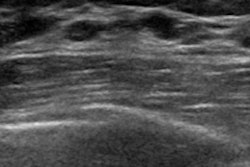
Shear-wave elastography (SWE) is a useful way to evaluate the depth of invasion of rectal tumors, offering clinicians another tool for preoperative surgery staging, according to a study published online May 10 in Ultrasound in Medicine and Biology.
Accurate staging of rectal cancer before surgery provides the crucial information needed to select appropriate treatment, and SWE can be used as an adjunct to traditional staging modalities such as endorectal ultrasonography (ERUS), wrote a team led by Dr. Zhihui Fan and colleagues of Peking University Cancer Hospital and Institute in Beijing.
"Shear-wave elastography can provide quantitative indicators of the depth of invasion of rectal tumors," the researchers wrote. "This method is tolerable, noninvasive, and easy to perform."
Increasing incidence
Rectal cancer is a common gastrointestinal disease, and its incidence continues to increase, according to Fan's group. The depth of the invasion of rectal cancer is a key prognostic factor and affects clinical treatment options, making preoperative staging crucial. Traditionally, this staging has been performed using ERUS or MRI, each of which has its limitations, according to the authors.
"MRI visualizes the rectal wall involved in rectal cancer adequately, but the examination time is long and the cost is high," the group wrote. "ERUS can visualize the structure of the different layers of the rectal wall clearly and determine the depth of tumor invasion, and the cost is low. ... Although the accuracy rate of ERUS is relatively high, there are still too many cases of overstaging or understaging. In addition, cancer staging by ERUS is heavily dependent on the operator's experience."
Use of SWE has increased, primarily for liver, breast, thyroid, and cervical lesions, but also for assessing prostate lesions. It's beneficial in characterizing tissue stiffness, and cancer tissue tends to be stiffer than healthy tissue. Yet SWE's utility for evaluating preoperative rectal cancer staging has not been studied. So Fan's team investigated the technique's value for this application compared with ERUS and MRI.
The study included 55 patients with rectal cancer who underwent ERUS, SWE, and MRI exams between September 2016 and April 2018. The average distance of each tumor from the anal verge was 6.9 cm. The average length was 3.1 cm and thickness 1.4 cm. All patients had undergone surgery, so the researchers used pathologic results as the gold standard for each modality/technique's performance.
Fan and colleagues found that SWE's overall concordance rate with pathologic stage was better than ERUS or MRI -- although the differences were not statistically significant, which the team attributed to the study's small sample size.
| Performance of ERUS, MRI, and SWE for assessing rectal cancer lesion depth | |||
| ERUS | MRI | SWE | |
| Rate of concordance | 78.2% | 74.6% | 85.5% |
What was statistically significant, however, was SWE's characterization of lesion stiffness by cancer stage: tumor stiffness increased as T-stage increased (p < 0.001).
Finally, the study found that among 27 cases of T1 rectal cancer, four ERUS cases and 10 MRI cases were overstaged; among 18 cases of T3 and T4 rectal cancer, eight ERUS cases and three MRI cases were understaged, according to the authors.
"At present, overstaging and understaging occur with both ERUS and MRI, which may result in unnecessary therapy or loss of opportunity for neoadjuvant therapy," they wrote.
Promising adjunct
Shear-wave elastography offers clinicians important rectal cancer treatment staging information, especially in cases with uncertain diagnosis, Fan and colleagues noted. But SWE should serve as a supplement to ERUS, not a replacement for it.
"A combined evaluation strategy, giving play to the strengths of the two methods, may be more sensible," they wrote.
More research is needed, according to the team.
"SWE is noninvasive, real-time, and inexpensive compared with MRI. It can provide quantitative diagnostic indicators and may be used as a supplement to conventional ultrasound," the group wrote. "To validate our findings, prospective studies with large samples are needed."




















